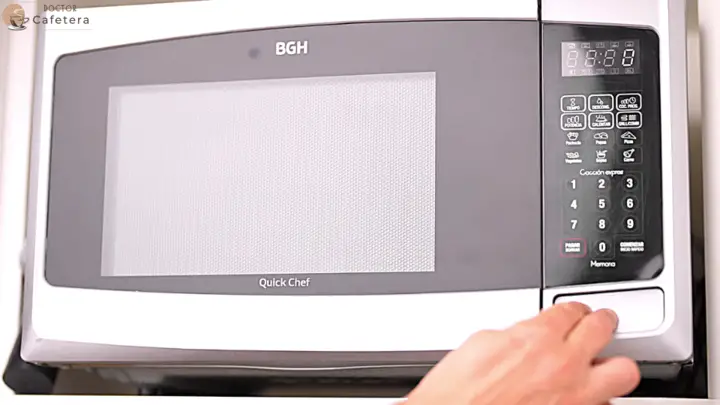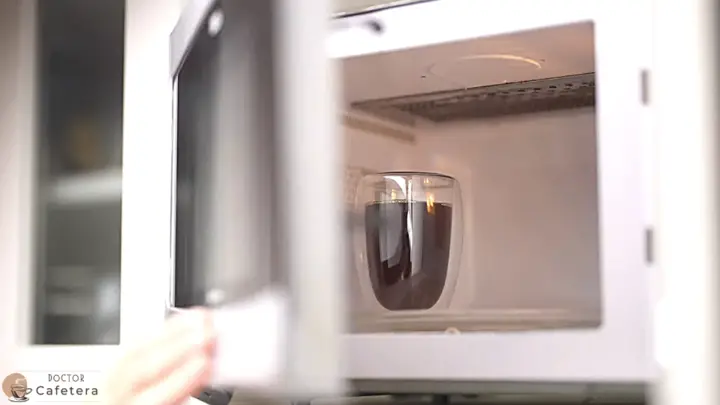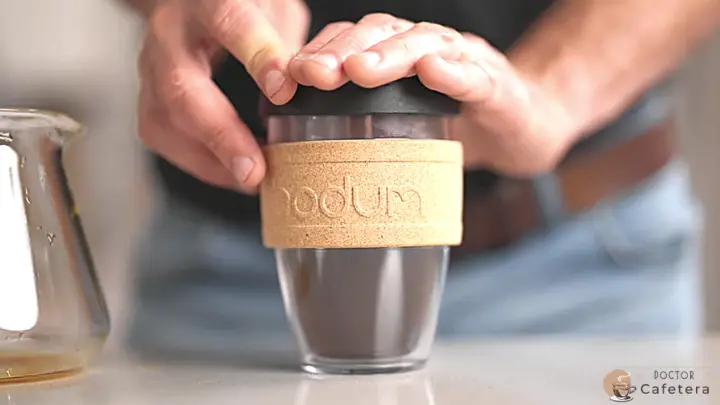Welcome to this new article, where I will talk about the science of heating coffee in a microwave. For a long time, there have been a lot of preconceived ideas about microwaving coffee; it has been said that microwaves can cause cancer, that they cause your coffee to become very bitter, that microwaving coffee is the worst thing to do, and a whole host of myths behind this.
But what are these myths? Where do they come from? To prepare this article, I consulted other articles I found by Dr. Samo Smrke and Dr. Christopher Hendon. Both contributed independently to understanding what it means to reheat coffee in the microwave and if it is as bad as they say.
The problem for many of us, and I include myself, is that we get so busy in the day that we can forget that we have made a delicious cup of coffee, and we only remember it when it is already cold, but we don’t want to drink it that way. Some choose to heat it in the microwave, while others refrain from thinking that this is such a bad thing that it can lead to cancer and even death.
So what I’m going to do here is take an objective scientific approach, and I’m going to take a look at these concerns from the perspective of a couple of chemists to clear up these doubts.
What is a microwave, and how does it work?
First, let’s talk about what a microwave oven is, what exactly this appliance is, what it is used for, how it works, and so on. In a nutshell, it is an appliance that uses electromagnetic radiation using microwaves to heat food.
Wavelengths are shot from one side to the other inside the microwave (wavelengths generally should be around 2.45 gigahertz, but in a microwave oven, they can be around 12.25 centimeters long), and these bounce off all the walls coming out of a magnetron. This device transforms electrical energy into electromagnetic energy in the form of microwaves.
Myths about coffee in the microwave
1. The waves that are generated inside the microwave can propagate to the outside
A question that may arise is… if I put my food in a glass container inside the microwave, the waves go out and go through the glass and eventually heat the food. And if the front cover of the microwave is also made of glass, can these waves pass through the cover and reach the outside?
The answer is no. There is a small method applied in microwave ovens, where the holes in the front cover are small enough not to allow the waves to pass through but large enough so that you can see your food as it cooks.
2. Coffee heated in the microwave can cause cancer
I can say with certainty that there should be no concern about this issue, and here I am going to bust this myth. There is no such thing as getting cancer from microwaves.
These devices are not powerful enough, nor can they ionize, so they can’t do what perhaps ultraviolet rays or X-rays can. Still, compared to these, microwaves are completely safe and just for babies, so you can rest assured that nothing will come out of them that will hurt you.
3. Microwaved coffee changes its taste; it becomes more bitter
There are several reasons people have a horrible experience with the taste of coffee after putting it in the microwave; here is what they are.
First, if you heat it too much, certain chemical reactions can affect the taste. Dr. Christopher Hendon assumes that if you heat it only around 130 to 140 degrees Fahrenheit (60 to 65 degrees Celsius) for no more than 30 seconds, this is the ideal temperature and time to have a good beverage, whereas, as the temperature decreases, you can appreciate all this acidity and sweetness that coffee has to offer.
Dr. Samo Smrke says that when coffee is cooling down, it is losing volatile aromatic compounds, which are, in turn, the ones that contribute to the whole range of flavors in the cup of coffee. So, as soon as the coffee begins to rest and cool, it is already losing its aromatic compounds, and if it is reheated, it will lose them even more.
Up to this point, I could say that there are good reasons for people to say that coffee should not be reheated or that it would be better to put some ice in it, enjoy it as it is, or prepare a new cup. I agree with what these two chemists say: do not worry too much; if your coffee gets cold, put it in the microwave and heat it to the ideal drinking temperature, but do not overheat it.
It is also important to note that some have said that caffeine could break down and cause changes in taste. Well, Dr. Hendon points out that caffeine is quite inert and very stable.
So for any reaction that would cause the caffeine to lose or break down, it is necessary to heat the beverage until evaporation occurs, after 350 degrees Fahrenheit (177 degrees Celsius). But even if you needed to heat it to that temperature, it would not be possible in a microwave, and in that case, you would have to heat it in small increments to reach the desired temperature.
Having said all that, and to combat the accusations of a more bitter cup of coffee, which I’m sure are justified, I should say that it’s likely that the flavor changes happen because as the coffee cools, more sweet and sweet and acidic flavors start to come out.
That is why in barista competitions, some use frozen spoons to cool the espresso quickly because that is where the most interesting flavors come through. These flavors are at their highest levels when they reach around 120-140 degrees Fahrenheit (50-60 Celsius), at which point a wider range of these flavors can be experienced.
Well, the same thing happens when the coffee cools down, we experience more sweetness and acidity because it is more perceptible than reheated due to the high temperatures. Still, of course, it will have less volatile aromatics since it cooled the first time.
This assumes that heating the coffee in the microwave does not negatively influence the flavor of the coffee because the flavor must have already changed since the first time it was cooled.
Are there other alternatives to avoid reheating coffee in the microwave?
There are often recommendations to use a thermos or something like an Ember cup to avoid overheating, which can be great, as they are excellent alternatives to keep the heat in. But that’s not really what we’re talking about here, as we’re talking more about coffee that has already cooled and not how to preserve its temperature.
I wouldn’t say I like thermoses, especially metal thermoses, with which I always get some metallic taste that I don’t enjoy. I like the Ember mug as it can be kept at a certain temperature; I, for example, tend to set it to the lowest temperature in case I forget, then it will stay there, and then I can turn it off without causing havoc.
But the longer the coffee stays in there will cause it to get too high a temperature which will encourage chemical reactions, just as happens when reheating at too high a temperature or for too long. The same thing happens in a thermos or similar; you can’t just keep the coffee hot for a long period because there will be reactions, as I mentioned.
In contrast, the microwave is so good and efficient because of how fast the coffee heats up, without giving the chemical compounds enough time to react.
Well, this is my little comment about thermoses, Ember cups, and the like; they are great alternatives that I recommend, so you don’t have to consider reheating your coffee, but you should know that they also have a time limit to keep the coffee tasty.
Conclusion
All in all, I can say that reheating coffee will never be the best thing in the world. Still, it is better than preparing a new cup of coffee, pouring ice in it, or sacrificing your drink completely and throwing it away; it is the best option among all the others.
So if you need to reheat your coffee, the best way to do it, as recommended by scientists, is to put it in the microwave until it is ready, without overheating it. Then you can enjoy the tasty flavor of a coffee without waste.
Related:



